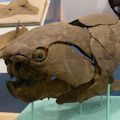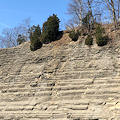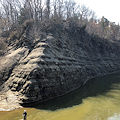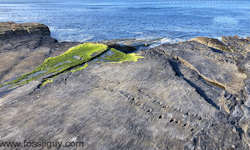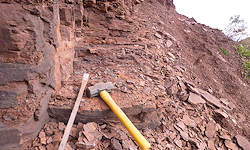Article written by: Jayson Kowinsky - Fossilguy.com
Dunkleosteus
Giant Predatory Placoderm of the Devonian

Reconstruction of Dunkleosteus terrelli. This is figure 4B from Ferron, Martinez-Perez, and Botellaa - 2017. Showing a palaeoartistic reconstruction of Dunkleosteus terrelli - Drawing by Hugo Salais, HS Scientific Illustration (Full Publication Here).
Fast Facts about Dunkleosteus - The Giant Armored Placoderm

This is an outdated reconstruction of a lifesized Dunkleosteus terrelli model in the background with a cast of the fossil body armor in the foreground. This is on display at the Rocky River Nature Center near Cleveland.
Name:
Dunkleosteus (pronunciation: "Dunkle-os-tee-us")
The name means "Dunkles Bone" - Named after paleontologist David Dunkle who described the fossils. Osteus is Greek for bone, referring to the giant bone plates that make up the head and jaws.
Taxonomy:
Class: Placodermi (Placoderm) - Order: Arthrodira - Family: Dunkleosteidae - Genus: Dunkleosteus - Species (up to 10 species)
Age: Late Devonian
Fossils of Dunkleosteus are found in late Devonian rock units which are Frasnian and Famennian in age (382-358 Myo).
Distribution: North America, Europe, and Morrocco:
Dunkleosteus specimens are found nearly globally, however the world famous specimens come from the Cleveland shale in Northern Ohio.
Extinction: End Devonian
Dunkleosteus became extinct along with all other Placoderms during the Devonian mass extinction event.
Discovery: Terrell 1867
Dunkleosteus remains were first discovered by amateur paleontologist Jay Terrell and his son in 1867 along the Lake Erie cliffs at the town of Sheffield Lake. He called this animal Terrible Fish. This animal was rediscovered by paleontologist David Dunkle. The largest species was eventually named Dunkleosteus terrelli in honor of Dunkle and Terrell.
Size: Maximum size esimates range from 3 meters to around 8 meters (11-26 feet).
Although no one is sure of it's exact size, Dunkleosteus terrelli was the largest species and was most likely the most massive fish in the Devonian!
Diet: Carnivore
Being one of the the largest and most powerful fish ever, it could eat just about anything. There's even evidence of cannabalism!
Armor: Tank-like Armor
Dunkleosteus head and jaws were composed of heavily armored plates.
Fun Facts:
Like all Placoderms, Dunkleosteus was toothless. However, it's armored jaw plates formed massive self sharpening blades!
At 1,000 pounds (21,000 pounds per square inch), Dunkleosteus could chomp straight through bone. This force
is on par with Giant Crocodiles!
Introduction to Dunkleosteus

Rendering of Dunkleosteus terrelli by Julian Johnson-Mortimer (CC BY 3.0).

This is a beautiful wire model of Dunkleosteus terrelli hanging at the Indiana State Museum.
With a maximum size somewhere between 3-8 meters, or 11-26 feet in length, Dunkleosteus terrelli was the largest Placoderm to ever exist. Like all Placoderms, D. terrelli had thick, tank like exterior armor covering the fish's head, jaws, and thorax. A recent reconstruction of this late Devonian apex predator by Ferron et al. 2017 is shown in the image near the top of this page.
Species and Range
Dunkleosteus terrelli was the largest and most well studied species, however, there were many other smaller species. Although many are based on sparse and fragmentary remains, there have been at least 8 accepted species. The following species are often considered valid: D. amblyodoratus, belgicus, denisoni, magnificus, missouriensis, newberryi, terrelli, and raveri.
Also of note is a species found in Morocco called D. marsaisi. This would be the only occurrence of Dunkleosteus in the southern Rheic Ocean. However, many researchers believe it belongs in a different genus, Eastmanosteus marsaisi. The remaining species all occur in either North America (U.S. and Canada), or Western Europe. These areas would all be around the same geographical region at the time, which was a shallow subtropical sea north of the Rheic Ocean seen in the image below (This is the lighter blue area to the left of the "NA" on the map).

On the map, D. terrelli's range was the entire light blue shallow sea left of the "NA" label. During the late devonian, most of North America was underneath a shallow sea. Specimens of D. terrelli are found from Pennsylvania to California, down to Texas. The Rheic Ocean is the narrow ocean separating North America from Gondwana. Image from Ron Blakey via Wikipedia (Creative Commons Attribution license).
Appearance and Size Estimates

Latest reconstruction of the largest known Dunkleosteus terrelli specimen (CMNH 5936). This is from Engleman 2013, Figure 13.
Except for a specimen with 20 associated vertebra (Jackson et al. 2012), and a handful of specimens that preserve parts of the pectoral fin (Carr et al. 2010), only the thick bony plates of Dunkleosteus' head, jaws, and thorax have been found. As a result, reconstruction of the entire animal has been tricky.
Previous reconstructions were based on a placoderm that was much smaller, but had similar looking body plates. This placoderm is called Coccosteus.
Unfortunately, Coccosteus lived in fresh water and thus had a very different mode of life, so it probably looked different. More recently, a reconstruction by Ferron et al. 2017 used inferences from Dunkleosteus pelagic swimming and feeding habits.
They noted their lifestyle was similar to that of a pelagic shark and adjusted the body morphology to suit. This is also in agreement with Carr et al. 2010, that states the preserved fin outlines are more like chondrichthyans (sharks).
This more pelagic reconstruction is shown toward the top of this page.

This is Figure 6C from Carr et al. 2010 showing specimen CMNH 8982. It's the ventral (bottom) side of a well preserved portion of D. terrelli. The head is at the anterior end, with the lower jaw and cusps visible. Toward the left where the dotted lines are is part of a preserved pectoral fin (which is the subject of the figure in the publication). The scale bar = 10 cm. Here is the full article: Carr et al, 2010.
Additionally, the size of D. terrelli is difficult to pinpoint since inferences must be made about most of the body. As a result, there are many different size calculations.
Carr (2010) places a large D. terrelli at very conservative 4.6 m (15 feet), while Anderson and Westneat 2007 places a large one at 6m (19.6 feet).
In recent reconstruction attempts using jaw perimeter and pelagic sharks that had similar ecological niches, Ferron et al. 2017 places a very large specimen, CMNH 5936, at 8.79 m (28.8 feet).
Although this estimate is large, Ferron et al. 2017 has a limit and says estimates of 10 meters are most likely overestimates.
Finally, the most recent reconstruction is by Engelman (2023). He returns back to the more placoderm looking body form instead of the streamlined pelagic form. As a result, his calculations are more stout, with a maximum size of around 3.34 meters or 11 feet. This reconstruction
is shown in the diagram at the top of this section.
So, there appears to be two main reconstrucitons. The pelagic body form gives a reasonable estimate around 20 feet, and the traditional placoderm body form gives a maximum estimate around 11 feet.

This is Figure 2 from Carr 2010 showing a life reconstruction of D. terelli and views of the ossified skeleton. Here is the full article: Carr, 2010.
Jaws and Bite Force
Dunkleosteus terrelli was one of the first true apex predators to appear on Earth (Anderson & Westneat 2007), meaning it could eat any animal it wanted and had very little predators. How could it do this? It's partly due to the animal's giant size and partly due to the jaws. Boney plates making up the jaws were sculpted into fangs and long slicing edges. The upper and lower jaws would also shear against one another causing them to self-sharpen!

Image of the lower jaw of Dunkleosteus terrelli showing the self-sharpening fang and blade edge.
Moreover, Anderson and Westneat (2007) studied the feeding mechanics and the bite force of Dunkleosteus terrelli jaws. They made two key findings. First, they discovered the jaws could rapidly open and close. So fast that Dunkleosteus could make a suction when opening, sucking prey into it. Secondly, they found the jaws to have a tremendous bite force, on par with giant crocodiles. One of the larger specimens studied, CMNH 5768, which is estimated to be 6 meters in length had a bite force of 4,400 N (989 pounds) on the cusps and 5,300 N (1,200 pounds) on the end of the blade. Putting this in terms of pressure, this is 147 million Pascals or 21,000 psi (Anderson and Westneat 2007).
Combined, Dunkleosteus could suck in and bite straight through any animal alive at that time, from the thick shelled Ammonites, to other Placoderms with body armor. In fact, a study by Hall et al., 2016 found scrape and puncture marks on other Dunkleosteus armor that were made by larger Dunkleosteus. This means they may have even eaten eat other!
Another interesting fact is the Jaw shape of Dunkleosteus changed as it grew from juvenile to adult. A study by Boyle et al. showed the jaw became more elongated and grew a longer anterior fang, or cusp. The study concludes as the animal grew, the diet shifted from soft-bodied prey, such as fish and sharks to larger armored prey, such as placoderms (Boyle at al 2016). This shift in diet is common in top predators as they grow from juvenile to adult.

This is a Dunkleosteus terrelli suborbital bone (CMNH 5302) showing tooth scrape and puncture marks made by another Dunkleosteus. Fossil images and displays are from the Cleveland Museum of Natural History.
Extinction

The large Dunkleosteus terrelli specimen named Dunk at the Cleveland Museum of Natural History.
Dunkleosteus lived during the Late Devonian time period, from 385 to 359 mya. When Dunkleosteus appeared, it quickly diversified into many species, however, it could not survive the end Devonian mass extinction events. Two extinction events occurred at the end of the Devonian, the Kellwasser Event and later the Hangeberg Event. The last event, the Hangenberg event, wiped out both marine and terrestrial vertebrates. It completely destroyed many marine ecosystems. By the end of the Devonian, 70 to 80% of all species on Earth, including all Placoderms were extinct.
Discovery and Historical Locations

Peter Bungart posing with his reconstructed Dunkleosteus and the largest jaw yet found.
Caption from Hyde Collection: Dinichthys terrelli. No. 768, C.M.N.H., with largest jaw yet found, no. 5936, C.M.N.H.
Image used with permission from The Jesse Earl Hyde Collection, Case Western Reserve University (CWRU)
Department of Geological Sciences. Hyde Collection.
1867 - Original Discovery
Dunkleosteus terrelli was first discovered in 1867 along the shale cliffs of Cove Beach in the town of Shefield Lake, OH. Terrell, a local hotel owner, would often walk the beach and fish and fossil collect with his son. In 1867 he found
partial armor plates to a massive placoderm that he coined Terrible fish. Over the years more and more fragments of this Terrible fish were found.
1928 - Rocky River Specimens

Peter Bungart excavating the large Dunkleosteus from the Rocky River Reservation.
Caption from Hyde Collection: Cleveland Shale, Rocky River, first bank below Cedar Point. Discovery of Dinichthys, Specimen, 768 of C.M.N.H.
Image used with permission from The Jesse Earl Hyde Collection, Case Western Reserve University (CWRU)
Department of Geological Sciences. Hyde Collection.
In the 1920's the Big Creek watershed was excavated by large steam shovels to improve water drainage. The large equipment cut through the Cleveland Shale. Paleontologists from the newly formed Cleveland Museum of Natural History (CMNH) Peter Bungart and Jesse Earl Hyde were on site at the excavations searching the concretions for fossils. In 1928, at the Rocky River Reservation, Bungart and Hyde found the largest and most complete Terrible Fish of the time. Over the next few years, Bungart painstakingly pieced the animal back together. Fortunately, Hyde took numerous photos throughout the 1920's of the fossil excavations. These are now stored in the Hyde Collection. Some of these images are shown here and below in the thumbnail gallery.
1956 - Scientific Naming
In 1956, the Terrible Fish was given the scientific name Dunkleosteus terrelli, in honor of Dr. David Dunkle, the first museum curator who did extensive work with the specimens, and Jay Terrell who first discovered the animal.
1965 - I-71 Construction
The local rivers draining from Lake Erie (including the Rocky River) were a source of most Dunkleosteus fossils until 1965. In the mid 60's the Ohio department of transportation built the I-71 Corridor. The new highway cut through Big Creek Valley which contains the black shales of the ancient Devonian seabed. The CMNH coordinated with the Department of Transportation and excavated large quantities of fossils during the construction process. They found tons of specimens, from new sharks to new species of placoderms. The CMNH still has shelves of material from the I-71 project to prep and study.
Below is a video from PBS Eons about Placoderms, including Dunkleosteus.
When Fish Wore Armor: Placoderms - Including Dunkleosteus.
Richard Raponi has a nice article on the discovery history of Dunkleosteus if you want to learn more details (see references below).
Additional Photos of Dunkleosteus, the Cleveland Shale, and Historical Discovery Photos:
Historical Photos in this thumbnail gallery are used with permission from The Jesse Earl Hyde Collection, Case Western Reserve University (CWRU) Department of Geological Sciences.
Historical Photos
Cleveland Museum of Natural History
Rocky River Reserve and Nature Center - 1928 Excavation site of famous specimen CMNH 768
Shell Cove - Jay Terrell's 1867 Dunkleosteus Discovery Location
References / Works Cited
Anderson, Philip & Westneat, Mark. (2007) Feeding mechanics and bite force modelling of the skull of Dunkleosteus terrelli, an ancient apex predator. Biology letters. 3. 76-9. 10.1098/rsbl.2006.0569. Publication here
Boyle, J. T., Ryan, M., Snively, E., and Hlavin, W. J. (2016) Jaw ontogeny of the late Devonian "T. rex" with implications for feeding strategies and life history of the arthrodire Dunkleosteus terrelli. Journal of Vertebrate Paleontology, Programs and Abstracts, 2016, 103. Poster here
Carr, Robert. (2010) The Cleveland Museum of Natural History PALEOECOLOGY OF DUNKLEOSTEUS TERRELLI (PLACODERMI: ARTHRODIRA). 57. 36-45. Publication here
Carr, Robert & Lelievre, Herve & L. Jackson, Gary. (2010) The ancestral morphotype for the gnathostome pectoral fin revisited and the placoderm condition. In: Morphology, Phylogeny and Paleobiogeography of Fossil Fishes: Honoring Meemann Chang, Publisher: Verlag Dr. Friedrich Pfeil, Editors: David K. Elliott, John G. Maisey, Xiaobo Yu, Desui Miao
Ferron, H. G., Martinez-Perez, C., & Botella, H. (2017) Ecomorphological inferences in early vertebrates: reconstructing Dunkleosteus terrelli (Arthrodira, Placodermi) caudal fin from palaeoecological data. PeerJ, 5, e4081. doi:10.7717/peerj.4081 Publication here
Hall, L., Ryan, M., and E. Scott. 2016. Possible evidence for cannibalism in the giant arthrodire Dunkleosteus, the apex predator of the Cleveland Shale Member (Fammenian) of the Ohio Shale. Journal of Vertebrate Paleontology, Programs and Abstracts, 2016, 148.
Jackson, G., Chapman, D., Boyle, J.T., Zelinski, D., Martin, T.G., Klunder, J.F., Reich, K., Reich, M., Robison, T.L. & Ryan, M.J. (2012) The most complete vertebral column of Dunkleosteus terrelli: results of the continuing Late Devonian Cleveland Shale (Famennian) fish research at the Cleveland Museum of Natural History. - 46th Annual Meeting (23-24 April 2012). Abstracts with Programs 44, No. 5: 66. Geological Society of America.
Richard Raponi, "Dunkleosteus," Cleveland Historical, accessed February 20, 2019, https://clevelandhistorical.org/items/show/728.
Russell K. Engelman. (2023) A Devonian Fish Tale: A New Method of Body Length Estimation Suggests Much Smaller Sizes for Dunkleosteus terrelli (Placodermi: Arthrodira). Diversity; 15 (3): 318 DOI: 10.3390/d15030318.














